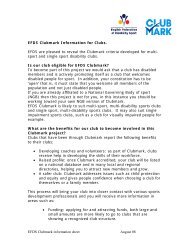OO213 - English Federation of Disability Sport
OO213 - English Federation of Disability Sport
OO213 - English Federation of Disability Sport
- No tags were found...
Create successful ePaper yourself
Turn your PDF publications into a flip-book with our unique Google optimized e-Paper software.
CHAPTER 3A STRONGFOUNDATIONGood health, nutrition and a solid education: These arethe building blocks <strong>of</strong> life that children and their parentswant, and to which all children are entitled.Inclusive healthUnder the Convention on the Rights <strong>of</strong> theChild (CRC) and the Convention on the Rights<strong>of</strong> Persons with Disabilities (CRPD), all childrenhave the right to the highest attainable standard<strong>of</strong> health. It follows that children with disabilitiesare equally entitled to the full spectrum <strong>of</strong> care– from immunization in infancy to proper nutritionand treatment for the ailments and injuries<strong>of</strong> childhood, to confidential sexual and reproductivehealth information and services duringadolescence and into early adulthood. Equallycritical are such basic services as water,sanitation and hygiene.Ensuring that children with disabilities actuallyenjoy these rights on a par with others is theobjective <strong>of</strong> an inclusive approach to health. Thisis a matter <strong>of</strong> social justice and <strong>of</strong> respecting theinherent dignity <strong>of</strong> all human beings. It is alsoan investment in the future: Like other children,those with disabilities are tomorrow’s adults.They need good health for its own sake, forthe crucial role it plays in facilitating a happychildhood and for the boost it can give theirprospects as future producers and parents.ImmunizationImmunizations are a critical component <strong>of</strong>global efforts to reduce childhood illness anddeath. They are among the most successful andcost-effective <strong>of</strong> all public health interventions,with the strong potential to reduce the burden <strong>of</strong>morbidity and mortality, particularly for childrenunder 5 years <strong>of</strong> age. For this reason, immunizationhas been a cornerstone <strong>of</strong> national and internationalhealth initiatives. More children than everbefore are being reached. One consequence hasbeen that the incidence <strong>of</strong> polio – which can leadto permanent muscle paralysis – fell from morethan 350,000 cases in 1988 to 221 cases in 2012. 34There is still a considerable way to go. In 2008,for example, over a million children under5 died from pneumococcal disease, rotavirusdiarrhoea and Haemophilus influenzae type B.Vaccination can actually prevent a large number<strong>of</strong> these deaths. 35The inclusion <strong>of</strong> children with disabilities inimmunization efforts is not only ethical butimperative for public health and equity: Goals<strong>of</strong> universal coverage can only be achieved ifchildren who have disabilities are included inimmunization efforts. 36While immunization is an important means <strong>of</strong>pre-empting diseases that lead to disabilities, itis no less important for a child who already has adisability to be immunized. Unfortunately, manychildren with disabilities are still not benefitingfrom increased immunization coverage, thoughthey are at the same risk <strong>of</strong> childhood diseasesas all children. If they are left unimmunized orA STRONG FOUNDATION23











